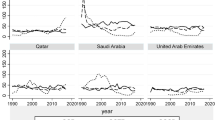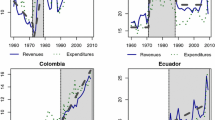Abstract
In this paper we study the relationship of fiscal policy and economicperformance of some core countries in the EU. Our aim is to find outwhether public deficit and public debt have consequences for real variables in the economies we consider. The background of our empirical study is a growth model that provides us with some predictions on the relationship between fiscal policy and economic growth. In a first step we then use Granger causality tests to analyze empirically whether some of the implications of our model arecompatible with the data. In a second step, we investigate whether the fiscalpolicies of the member states have been sustainable. Given this information,we then pursue the question of whether differences in the fiscal positions ofcountries have consequences as concerns the outcome of our empirical testsof step one. Finally, we study whether the impact of the public deficit ratiodepends on the magnitude of the debt ratio.
Similar content being viewed by others
References
Alesina, Alberto and Perotti, Roberto (1995) 'Fiscal Expansions and Fiscal Adjustments in OECD Countries', Economic Policy 21, 205–248.
van Aarle, Bas, Garretsen, Harry, and van Moorsel, Cornelie (1999) 'Fiscal Retrenchment in the Transition to EMU', Working Paper, University of Leuven.
Barro, Robert J. (1990) 'Government Spending in a Simple Model of Endogenous Growth', Journal of Political Economy 98, S103–S125.
Blanchard, Olivier, Chouraqui, Jean-Claude, Hagemann, Robert P., and Sartor, Nicola (1990) 'The Sustainability of Fiscal Policy: New Answers to an Old Question', OECD Economic Studies 15, 7–36.
Bohn, Henning (1995) 'The Sustainability of Budget Deficits in a Stochastic Economy', Journal of Money, Credit, and Banking 27, 257–271.
Bohn, Henning (1998) 'The Behavior of U.S. Public Debt and Deficits', Quarterly Journal of Economics 113, 949–963.
Campbell, John (1994) 'Inspecting the Mechanism: An Analytical Approach to the Stochastic Growth Model', Journal of Monetary Economics 33, 463–506.
European Commission (1998) 'Statistical Annex', European Economy, No. 65, Directorate for Economic and Financial Affairs, Brussels.
Feve, Patrick and Henin, Pierre-Yves (1996) 'Assessing Maastricht Sustainability of Public Deficits in a Stochastic Environment', mimeo CEPREMAP, Paris. Paper presented at the CEEASymposium on Problems of European Monetary Union, Frankfurt, November 1996.
Flood, Robert P. and Garber, Peter M. (1980) 'Market Fundamentals Versus Price Level Bubbles: The First Tests', Journal of Political Economy 88, 745–770.
Giavazzi, Francesco and Pagano, Marco (1990) 'Can Severe Fiscal Adjustments Be Expansionary?', in Olivier Blanchard and Stanley Fischer, eds, NBER Macroeconomics Annual 1990, Cambridge, MA: MIT Press.
Greiner, Alfred and Semmler, Willi (1999) 'An Endogenous Growth Model with Public Capital and Government Borrowing', Annals of Operations Research 88, 65–79.
Greiner, Alfred and Semmler, Willi (1999a) 'An Inquiry into the Sustainability of German Fiscal Policy: Some Time Series Tests', Public Finance Review 27, 221–237.
Grilli, Vittorio (1988) 'Seignorage in Europe', in M. De Cecco and A. Giovannini, eds, A European Central Bank? Perspectives on Monetary Unification after Ten Years of the EMS, Cambridge: Cambridge University Press.
Hamilton, Flavin and Flavin, Marjorie (1986) 'On the Limitations of Government Borrowing: A Framework for Empirical Testing', American Economic Review 76, 808–819.
King, Robert G., Plosser, Charles I., and Rebelo, Sergio T. (1988) 'Production, Growth and Business Cycles I: The Basic Neo-classical Model', Journal of Monetary Economics 21, 195–232.
Kremers, Jeroen M. (1989) 'U.S. Federal Indebtedness and the Conduct of Fiscal Policy', Journal of Monetary Economics 23, 219–238.
OECD (1999) Fiscal Positions and Business Cycle Statistics, Organisation for Economic Development and Cooperation, Paris.
Perotti, Roberto (1999) 'Fiscal Policy in Good Times and Bad', Quarterly Journal of Economics 114, 1399–1436.
Trehan, Bharat and Walsh, Carl E. (1991) 'Testing Intertemporal Budget Constraints: Theory and Applications to U.S. Federal Budget and Current Account Deficits', Journal of Money, Credit, and Banking 23, 206–223.
Wickens, Michael (1993) 'The Sustainability of Fiscal Policy and theMaastricht Conditions', Centre for Economic Forecasting, London Business School, Discussion Paper No. 10-93.
Wilcox, David W. (1989) 'The Sustainability of Government Deficits: Implications of the Present-Value Borrowing Constraint', Journal of Money, Credit, and Banking 21, 291–306.
Author information
Authors and Affiliations
Rights and permissions
About this article
Cite this article
Gong, G., Greiner, A. & Semmler, W. Growth Effects of Fiscal Policy and Debt Sustainability in the EU. Empirica 28, 3–19 (2001). https://doi.org/10.1023/A:1010983716741
Issue Date:
DOI: https://doi.org/10.1023/A:1010983716741




